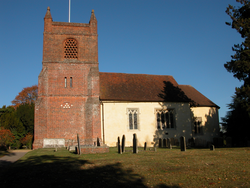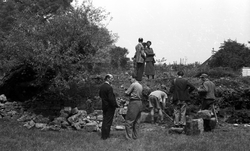
The Corpus of ROMANESQUE SCULPTURE in Britain & Ireland

Wokingham (now)
Parish church
Sonning is an attractive village on the Thames, NE of Reading. St Andrew's is at the western edge of the village, close to the river. As it stands the church consists of a rectangular nave and chancel with N and S aisles throughout, the chancel aisles, slightly wider than those of the nave, forming chapels and a vestry. There are nave doorways covered by porches to N and S, and a W tower. The fabric is all of flint with ashlar dressings. The VCH identifies a complex building history beginning in the 13thc., but the overall visual effect is of Woodyer's extensive restoration of 1852. The interest of the church lies in the carved stones, presumably from Reading Abbey, set into the tower (which became unstable and was rebuilt at the Reformation), and in an elaborate pillar piscina, repositioned against a pier of the N arcade opposite the N doorway.
Parish church
Wokingham is a market town 7 miles SE of Reading. The NE part of the town was an exclave of Wiltshire until 1844, when it was attached to Berkshire. All Saints' church is on the E edge of the town centre and stands in its own substantial churchyard. It is a large church, comprehensively restored by Woodyer, 1864-66, with a W tower of brown conglomerate (now whitewashed), five-bay nave with N and S aisles and chancel with chapel to S and vestry to N. The 5-bay nave arcades are carried on cylindrical columns and are certainly medieval, probably 15thc. No Romanesque sculpture was found, but Woodyer's S doorway may be a copy of a 12thc. original.
Parish church
Shinfield is a village on the southern edge of Reading, from which it is separated by the M4 and Reading's outer ring road. This double barrier has protected Shinfield from Reading's spread to some extent, although it largely has the character of a large housing estate, and the most attractive and oldest parts are clustered around the church. This has a flint nave with a 19thc. S aisle, a square early 14thc. chancel, a S chapel (dated 1526), and a red brick W tower of 1664. There is a 12thc. N doorway, protected by a timber porch.
Parish church
Finchampstead is in the south of the county, 7 miles SE of Reading and under a mile from the Hampshire border. It lies on the Roman road from London to Bath (the eastern part, from London to Silchester is known as the Devil's Highway). It is a good sized village, and the church stands in the old centre on a prominent hill. St James's has a rectangular 12thc. nave (two N windows visible inside) and apsidal chancel, with a square red brick W tower of 1720. On the N side is a chapel running the length of the chancel and most of the nave with arches from both. This addition is dated 1590 TH (above the outer door). Nave, chancel and N chapel are all rendered. Romanesque sculpture is confined to a font and a pillar piscina.
Parish church
Ruscombe is a village in the Thames Valley to the east of Twyford, between Reading and Maidenhead. It is close to the A4, but not so close that its village character is lost; in fact it lies on the minor road linking Twyford to Windsor, the B3024. The church stands in the village centre, and comprises a 12thc. flint chancel, brick nave and W tower of 1638-39. The only Romanesque features are a pillar piscina and the recut font.
Parish church
Wargrave is a large village in the Thames valley near the confluence with the Loddon, midway between Reading and Maidenhead. The medieval church was burnt down in 1914 and rebuilt by W. Fellowes Prynne, incorporating some of the original fabric, including the 1635 brick W tower and the 12thc N doorway (reset towards the W end of the N nave wall). The church has a nave with a S aisle and the remains of a blocked 12thc. arcade in the N wall. There is also a N transept and a square chancel. There is a disused plain font, probably 12thc., in the churchyard.
Parish church
Swallowfield is a village on the Blackwater river, 5 miles S of the centre of Reading and a mile from the Hampshire border. The village itself is largely 19thc and later, and the church stands well outside the centre to the E, on the edge of Swallowfield Park. Flint-faced 12thc. nave and 13thc. chancel roofed as one, with a timber-framed bellcote with brick nogging, topped by a stumpy broach spire at the W end. The chancel E wall is 19thc. and there is an added N transept of ashlar. Features of interest are the N and S nave doorways, the latter heavily restored.
Parish church
Hurst is a village in the SE of the county, just outside the western edge of Reading and three miles N of Wokingham. St Nicholas' church is on the southern edge of the village, and consists of a nave with separately roofed aisles and a modern S porch, a chancel with a N chapel and a 19thc N vestry, and a W tower of 1612. Construction is of flint except for the brick W tower. Inside, the nave arcades are of three bays; the two E bays of the N arcade are 12thc., but the W bay is significantly later, perhaps c.1300. The S arcade is mid-13thc. work with complex moulded capitals and pointed arches with multiple mouldings. The 12thc. parts of the N arcade are recorded here.
The church was formerly chapel of ease to Sonning.
Private house
Borough Marsh is an island surrounded by the rivers Thames and Loddon and their tributaries, between Shiplake and Wargrave. These gateposts with beakhead voussoirs built into them were crucial to the rediscovery of carved stones from the cloister of Reading Abbey. Just before the outbreak of World War II, Dr Wilfred Bowman bought Barn Acre Cottage in Borough Marsh near Wargrave. He intended to use it as a summer cottage, but he and his family took more-or-less permanent residence there after the air raids on London began. While gardening Dr Bowman unearthed the two beakhead voussoirs recorded here, and had them incorporated into the gateposts of a new set of gates for the cottage. In 1948 the stones were noticed by René Ledésert, a specialist in French literature based in London, who brought them to the attention of his friend George Zarnecki at the Courtauld Institute of Art, who recognised them as stones from Reading Abbey, and began a correspondence with Dr Bowman that resulted, later the same year, in the Courtauld Institute excavation of Dr Bowman's garden, and the discovery of some sixty carved stones that are now in Reading Museum. For an account of how the stones may have come to Borough Marsh, and more details of the excavation, see Baxter and Harrison (2002) and Zarnecki (1949 and 1950). An account of the excavation has been compiled by Tessa Smith, Dr Bowman's daughter, which includes photographs and copies of correspondence.
School
The Bluecoat School was founded in 1646 by Richard Aldworth, a merchant, as a charitable foundation (Aldworth's Hospital) to support 20 poor boys and their schoolmaster. Its original home was near St Mary's in Reading, but in January 1947 it moved to Holme Park, its present home, well known as the site of the medieval palace of the Bishops of Salisbury, and the place where Charles Keyser discovered the 15 capitals and two voussoirs that form the core of the collection of Reading Abbey cloister stone now in Reading Museum (qv).









